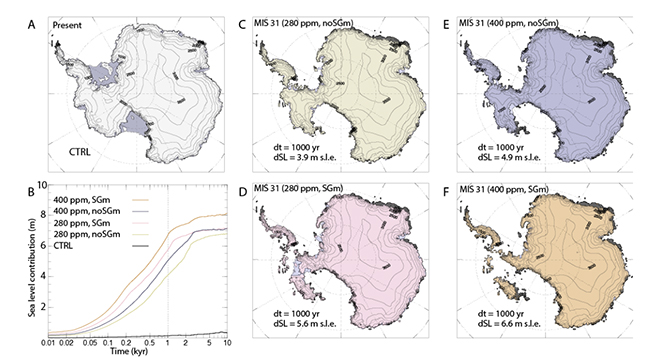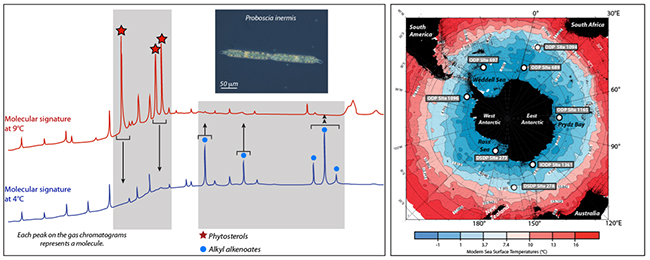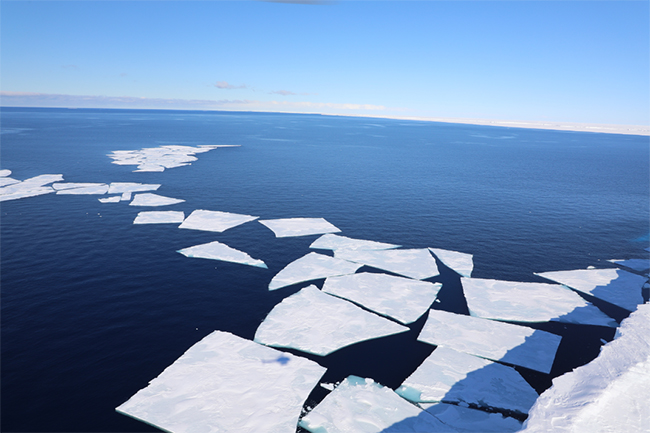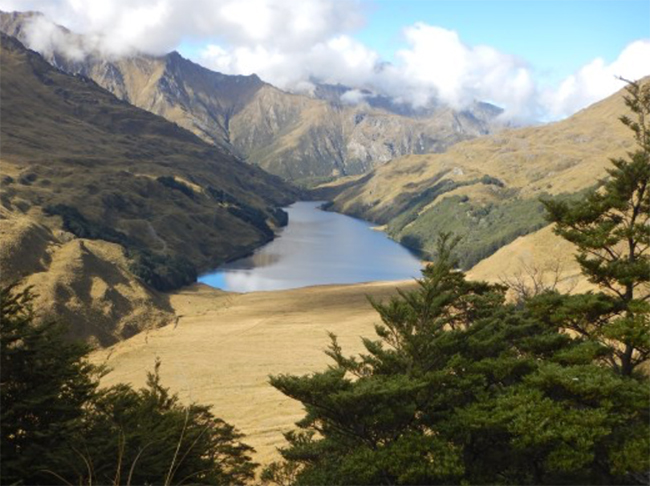Our research group is multidisciplinary. It gathers marine science researchers, geologists, geographers and chemists who study past and recent sea surface temperatures, ocean currents and wind patterns with a special focus on the Southern Ocean and Antarctica regions.
Our group also includes social anthropologists and anatomists who have a special interest in identifying organic molecules in archaeological remains to characterize plant use and environmental modifications in Melanesia.
The Organic Geochemistry Research Facility is used in the following research fields:
- Reconstructing past climates (ocean temperatures, continental rainfall, wind patterns)
- Reconstructing wind, rainfall and plant communities in prehistoric New Zealand
- Archaeological chemistry
- Past environment molecular proxy development
Recent and ongoing research projects
- Reconstructing Ancient ocean temperatures (Geology, Chemistry)
- New organic molecular proxy development (Geology, Chemistry, NIWA)
- Reconstructing wind, rainfall and plant communities in prehistoric New Zealand (Geology, Geography)
- Archaeological chemistry (Social Anthropology, Anatomy)
- Carbon sequestration in New Zealand's southern fiords
Equipment and capabilities
The key instruments of the Organic Geochemistry Research Facility include an accelerated solvent extractor (ASE), new generations of chromatographs including Gas Chromatograph with a flame ionization detector (GC-FID) and a Mass Spectrometer (GC-MS) and a High-Performance Liquid Chromatograph (HPLC-MS).
All the equipment for column chromatography fractionation is also available. This facility is used to characterize organic compounds extracted from natural sediment samples and archaeological artefacts.
Contact
Dr Catherine Beltran
Department of Geology
Principal Supervisor
Email catherine.beltran@otago.ac.nz
Catherine is a phytoplankton geochemist with special expertise in molecular paleothermometry and paleoclimate studies.
Organic Geochemistry research
Read about our ongoing and planned research projects.
Reconstructing Ancient ocean temperatures (Geology, Chemistry)
We reconstruct ancient ocean conditions from sediment cores. Such reconstructions may be the most accurate way of predicting how the ocean and Antarctic ice sheets will respond to anthropogenic climate change.
The Southern Ocean around Antarctica is warming and in some places the ice, which is in direct contact with the ocean, has started retreating. By studying sediment cores from the Antarctic margin, we can learn about past warm periods and how quickly the ice sheets retreated.
Organic molecules made by photosynthesising algae in the water column contain the fingerprints of ancient ocean conditions. These molecules can be extracted from sediments dating back 10's of millions of years and can be analysed using the suite of proposed chromatographs to determine the water temperatures with an astounding precision of +/-1°C. Such data are vital for climate models, which guide the Intergovernmental Panel on Climate Change (IPCC) reports.

Snapshots of Antarctic ice distribution 1.07 million years ago when the West Antarctic Ice Sheet collapsed due to Southern Ocean warming. A. represents the modern ice distribution and B. is the sea level contribution from ice melting through time. dSL is the sea level increase expressed in s.l.e. (sea level equivalent).
From Beltran et al. 2019, 'Southern Ocean temperature records and ice-sheet models demonstrate rapid Antarctic ice sheet retreat under low atmospheric CO2 during Marine Isotope Stage 31', Quaternary Science Reviews, 228.
doi:10.1016/j.quascirev.2019.106069
New organic molecular proxy development (Geology, Chemistry, NIWA)
We are working towards identifying new organic biomarkers for ocean reconstructions. This work is in its infancy but will include proxy development from marine diatom cultures for ocean temperature and sea-ice reconstructions that will shed new light on how the Antarctic Cryosphere evolved. We focus on identifying molecular markers for ocean productivity changes and a suite of New Zealand specific biomarkers.

Chromatograms of the aliphatic hydrocarbon fractions obtained for the diatom species Proboscia inermis cultured¬ at 4°C (blue line) and 9°C (red line). The grey shaded areas correspond to the main differences between both chromatograms. The molecular composition of P.inermis differs depending on the growth temperature: Phytosterols found at high levels in the 9°C cultures are not present in the cells grown at 4°C. Similarly, the alkyl alkenoates are produced at 4°C and not at 9°C.
Archaeological chemistry (Social Anthropology, Anatomy)
We apply archaeological chemistry to reconstruct the diet, trade and economy of ancient cultures, and how this has changed as populations evolved.
Many artefacts such as pottery, bones, and soil are porous and absorb organic molecules that can be extracted and characterized using the new instruments. A wide array of compounds has been detected on pottery including animal products, domesticated and wild vegetables, plant oils, and beeswax.
Otago researchers are currently collaborating on studies of prehistoric human diet in Melanesia. This technology will allow the teams to examine residues on stone tools and ceramic shards, to complement the ongoing molecular biological studies of human and animal remains.
Antarctic Science Platform 2019–2024
Programme 1 – The Antarctic ice-ocean-atmosphere system in a warming world
Ministry of Business, Innovation and employment - new Strategic Science Investment Fund (SSIF) platform for Antarctic science.

Project 1 – Antarctic Ice Dynamics –Past, Present and Future
Response of the West Antarctic Ice Sheet (WAIS) to projected warming remains a significant uncertainty in sea level rise projections.
This project will focus on understanding past and current drivers, mechanisms and feedbacks of ice sheet retreat to inform projections of future change and address the overarching question: How will marine-based ice sheets respond to a +2°C world, what are the planetary consequences of this response, and what are the consequences of surpassing +2°C?
The Organic Geochemistry Facility will be used to study the past ice sheet behaviour.
The researchers will measure Highly branched isoprenoids (HBI), a molecular proxy for past sea ice expansion, and Long Chain Diols (LDI) and TEX86, molecular sea surface thermometers preserved in the Ross Sea sediments (GC-MS, HPLC-MS).
Project 2 - Antarctic Ocean-Atmosphere Coupling
The ice, ocean and atmosphere around Antarctica are a very important part of our planet's climate system. However, this is also the hardest to measure geophysical domain on the planet. Despite this, it is very important that we improve our understanding of how they work as Antarctica's impact on the global Earth system will largely come through the oceanic transport of heat and other associated material like salt, carbon dioxide, oxygen and nutrients.
One of the objectives of this project is focused on the paleoceanographic insights into large-scale changes.
This objective requires paleoceanographic proxies to provide information about sea surface temperature (SST), salinity (melt water), ocean currents and circulation, mixing, stratification, and sea ice, with a focus on exploring the system's response to climatic shifts exceeding 2°C.
The Organic Geochemistry Facility is used to:
- Develop, validate and test novel molecular proxies against existing records (GC-FID, GCMS and HPLC-MS). Proxies providing information about the water column properties of the polar ocean is an emerging strength within the New Zealand research community.
- Develop new molecular paleothermometers from grow-out experiments of Southern Ocean phytoplankton (GC-FID, GC-MS).
- Test the emerging calibrations and proxies to warm climate intervals in new and existing sediment cores.
LAKES380 Program 2018–2022
MBIE- Endeavour Fund
LAKES380 website

During this five-year project, the health of New Zealand lakes will be characterized by analyzing sediment cores from 380 locations nationwide.
Lake sediments are natural archives that can provide information on current and historical aquatic communities, water quality and changes in the landscape. Using a range of techniques, scientists will explore how these lakes have changed over the past 1000 years. This will enable protection and revitalization of the precious New Zealand lake ecosystems and their cultural and environmental values and prioritize protection and mitigation strategies.
High resolution paleoclimate records spanning the last 1,000 years are critical for establishing hydroclimate baselines, determining the magnitude of past temperature change and evaluating potential climate drivers.
The Organic Geochemistry Facility is used for:
- Past lake water temperatures will be reconstructed using the TEX86 (HPLC-MS) temperature proxy.
- Past terrestrial vegetation composition reconstructions from analyses of plant-derived high molecular weight (HMW) n-alcohols and n-alkanes (GC-FID).
